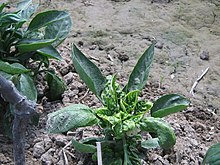
Back فيروس نبات Arabic উদ্ভিদ ভাইরাস Bengali/Bangla Virus de les plantes Catalan Fytovirus Czech Pflanzenvirus German Fitovirus Spanish ویروس گیاهی FA Phytovirus French पादप वाइरस HI Virus tumbuhan ID
This article needs additional citations for verification. (December 2023) |


Plant viruses are viruses that have the potential to affect plants. Like all other viruses, plant viruses are obligate intracellular parasites that do not have the molecular machinery to replicate without a host. Plant viruses can be pathogenic to vascular plants ("higher plants").
Most plant viruses are rod-shaped, with protein discs forming a tube surrounding the viral genome; isometric particles are another common structure. They rarely have an envelope. The great majority have an RNA genome, which is usually small and single stranded (ss), but some viruses have double-stranded (ds) RNA, ssDNA or dsDNA genomes. Although plant viruses are not as well understood as their animal counterparts, one plant virus has become very recognizable: tobacco mosaic virus (TMV), the first virus to be discovered. This and other viruses cause an estimated US$60 billion loss in crop yields worldwide each year. Plant viruses are grouped into 73 genera and 49 families. However, these figures relate only to cultivated plants, which represent only a tiny fraction of the total number of plant species. Viruses in wild plants have not been well-studied, but the interactions between wild plants and their viruses often do not appear to cause disease in the host plants.[1]
To transmit from one plant to another and from one plant cell to another, plant viruses must use strategies that are usually different from animal viruses. Most plants do not move, and so plant-to-plant transmission usually involves vectors (such as insects). Plant cells are surrounded by solid cell walls, therefore transport through plasmodesmata is the preferred path for virions to move between plant cells. Plants have specialized mechanisms for transporting mRNAs through plasmodesmata, and these mechanisms are thought to be used by RNA viruses to spread from one cell to another.[2] Plant defenses against viral infection include, among other measures, the use of siRNA in response to dsRNA.[3] Most plant viruses encode a protein to suppress this response.[4] Plants also reduce transport through plasmodesmata in response to injury.[2]
- ^ Roossinck, Marilyn J. (2011). "The good viruses: viral mutualistic symbioses". Nature Reviews Microbiology. 9 (2): 99–108. doi:10.1038/nrmicro2491. PMID 21200397. S2CID 23318905.
- ^ a b Oparka, Karl J.; Roberts, Alison G. (1 January 2001). "Plasmodesmata. A Not So Open-and-Shut Case". Plant Physiology. 125 (1): 123–126. doi:10.1104/pp.125.1.123. PMC 1539342. PMID 11154313.
- ^ Alberts, Bruce; Johnson, Alexander; Lewis, Julian; Raff, Martin; Roberts, Keith; Walter, Peter (2002). "7: Control of Gene Expression". Molecular Biology of the Cell. Garland Science. pp. 451–452. ISBN 978-0-8153-3218-3.
- ^ Ding, Shou-Wei; Voinnet, Olivier (2007). "Antiviral Immunity Directed by Small RNAs". Cell. 130 (3): 413–426. doi:10.1016/j.cell.2007.07.039. PMC 2703654. PMID 17693253.